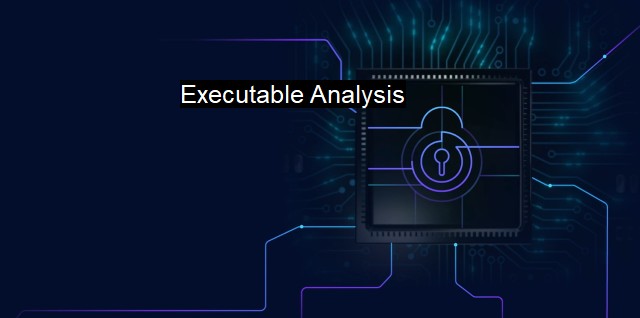What are Executable Analysis?
The Vital Role of Executable Analysis in Cybersecurity: Preventing Malicious Code and Defending Against Cyberattacks
Executable Analysis, in the domain of cyber security and antivirus is a multifaceted procedural framework composed of numerous intricate activities necessary to identify, streamline, isolate, investigate, and derive insights related to various aspects of an executable file. The primary goal of this approach is to mitigate potential security threats fostered by malicious executable content prevalent in today's digital landscape.Understanding 'Executable Analysis' requires a grasp of 'executable files'. These are a type-of distinct files in a computer that carries out tasks as per the encoded commands. This normally includes the software and applications that users interact with on a day-to-day basis. Despite being largely benign in nature, these executables can sometimes carry malicious code designed to illicitly gain access to systems, steal data, spy on user activities, or even cause catastrophic harm to the computer, making Executable Analysis a fundamental process in the field of cyber security.
A fundamental aspect of Executable Analysis lies in recognizing malicious executables, usually carried out using Antivirus programs. These programs are ingrained with signature-based detection, undertaking the task of mapping new files to existing databases of known threats. When a file is flagged, the antivirus program either quarantines or outright deletes it.
Cyber threats have evolved, constantly changing and adapting. The shortcomings of mere signature-based detection became clear as malicious coders designed their threats to change frequently or appear legitimate to bypass these systems. This necessitated the convergence of Executable Analysis with ‘Behavior-based Detection’, focusing on understanding how executables interact with a computer, rather than just what they are made up of.
Within this context, Executable Analysis can be disseminated into Static and Dynamic analysis. Static analysis scrutinizes an executables without running it, examining the raw hex, assembly code, strings, imported function calls, headers, among others, delineating the general behavior of the executable. It’s effective at providing an overview, but often not enough as clever attackers may use obfuscation techniques.
On the other hand, Dynamic analysis overcomes this hurdle by actively executing the suspicious file in a controlled environment, facilitating the monitoring of an executable’s behavior and its interaction with other system processes, files, and network activities, helping identify malicious traits otherwise undetectable.
An advanced concept within Executable Analysis is Automated Executable Analysis, which leverages AI and Machine Learning techniques to automate the process. This not only increases the efficiency of detecting potential threats, but also anticipates future attacks by identifying patterns in the malicious executable code.
Nonetheless, the intricacies within an executable render scanning a tremendously intricate process and numerous system resources are dedicated to examining each file, sometimes making the process quite heavy and slow for the system. That’s why there's an ongoing endeavor to optimize this process to detect threats rapidly as well as accurately.
Another associated challenge to Executable Analysis is false positives. They usually occur when legitimate executables exhibit similar characteristics to certain types of destructive codes. These can affect the day-to-day computing operation and is a challenge cybersecurity researchers constantly grapple with.
In spite of these challenges, the prospects of Executable Analysis remain irrefutable. In this perilous digital climate, it aids in safeguarding computers against an increasing universe of threats by significantly leveraging optics into the dynamically modulating cyber threat landscape.
Cybersecurity teams across the world use Executable Analysis in the ongoing race against the creators of malicious code. The battlefield where this ongoing war unfolds might be behind the screen, almost invisible, but crucial work performed by these cybersecurity warriors helps preserve the integrity of these valuable digital systems and fortify the bastions of a secure cyberspace.

Executable Analysis FAQs
What is executable analysis?
Executable analysis is the process of examining a binary executable file to understand its behavior and identify any malicious or suspicious activity that it may perform. This analysis is crucial in cybersecurity as it helps to detect malware and viruses that may harm computer systems.What is the purpose of executable analysis in antivirus software?
Antivirus software uses executable analysis to analyze the behavior of executable files and detect any potential threats. The software examines the code within the executable and compares it to a database of known malicious code to identify and prevent malware infections.What types of executable analysis techniques are used by antivirus software?
Antivirus software uses various techniques for executable analysis, including static analysis, dynamic analysis, and sandboxing. Static analysis examines the code without executing it, while dynamic analysis executes the code and observes its behavior. Sandboxing isolates an executable file in a virtual environment to observe its behavior without affecting the system's overall security.What are the benefits of executable analysis in cybersecurity?
Executable analysis plays a critical role in cybersecurity as it enables the detection and prevention of malware and viruses. By analyzing executables, antivirus software can identify and block malicious code before it can do any harm to a system. This helps to keep computers and networks secure and protects sensitive data from cyber threats.| | A | | | B | | | C | | | D | | | E | | | F | | | G | | | H | | | I | | | J | | | K | | | L | | | M | |
| | N | | | O | | | P | | | Q | | | R | | | S | | | T | | | U | | | V | | | W | | | X | | | Y | | | Z | |
| | 1 | | | 2 | | | 3 | | | 4 | | | 7 | | | 8 | | |||||||